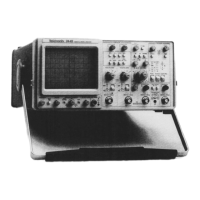
Do you have a question about the Tektronix 2445 and is the answer not in the manual?
| Type | Oscilloscope |
|---|---|
| Bandwidth | 150 MHz |
| Channels | 4 |
| Vertical Sensitivity | 2 mV/div to 5 V/div |
| Trigger Sources | CH1, CH2, CH3, CH4, Line, Ext |
| Rise Time | 2.3 ns |
| Time Base Range | 5 ns/div to 0.5 s/div |
| Input Impedance | 1 MΩ |
| Display | CRT |
| Trigger Modes | Auto, Normal, Single |
| Power Requirements | 48-440 Hz |
| Weight | 20 lbs |
Overview of the TEKTRONIX 2445 Oscilloscope: a portable 150-MHz, four-channel vertical deflection instrument.
Electrical characteristics valid for the 2445 under specified environmental and warm-up conditions.
Covers safety, voltage selection, fuse, power cord, cooling, and initial power-on procedures for instrument setup.
Explains power-up tests, failure indication, and provides repackaging instructions for shipping.
Front-panel controls for power, display brightness, focus, and graticule illumination.
Input connectors, coupling switches, and VOLTS/DIV settings for the vertical deflection system.
SEC/DIV switches, VAR control, TRACE SEP, and Horizontal POSITION for sweep speed and display.
Controls for MODE, SOURCE, COUPLING, LEVEL, SLOPE, and HOLDOFF for triggering sweeps.
Rear-panel connectors for signal outputs, Z-axis input, power, and voltage selection.
Alphanumeric display on CRT showing scale factors, trigger levels, and other information.
Graticule markings and basic methods for time and voltage measurements.
Connecting signals using probes and coaxial cables, and discusses probe compensation.
Using external signals as trigger sources for A or B sweeps.
Initial control settings, warm-up, and basic trace adjustments like rotation and focus.
Astigmatism, auto DC balance, and probe low-frequency compensation procedures.
Adjusting Channel 2 delay to match apparent delay in other channels.
Timing and amplitude checks using the CALIBRATOR signal for instrument verification.
Using the Delta Volts function for measuring voltage between any two points.
Using Delta Volts to compute the ratio between two different signal voltages.
Using ADD mode to eliminate unwanted common-mode signal components.
Using Delta Time function for time intervals and frequency measurements.
Measuring time differences between related pulses and time ratios like duty cycles.
Measuring phase difference between signals and using X10 MAG for small angles.
Introduction to delayed-sweep modes for timing and examining specific waveform points.
Using intensified zones and alternate display modes for accurate time measurements.
Making time difference measurements using delayed sweep methods.
Configuration for rackmounting and the optional rear-support kit.
Tektronix part numbers for international power cords and associated fuses.
Accessories provided with each instrument.
Recommended optional accessories for use with the 2445 Oscilloscope.
Confirms proper operation of microprocessor memory and instrument options.
Checks instrument functionality and option presence after Kernel tests, indicating failures.